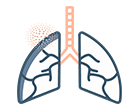Afzelius B. A. (1976). A human syndrome caused by immotile cilia. Science (New York, N.Y.), 193(4250), 317–319. https://doi.org/10.1126/science.1084576
Noone, P. G., Leigh, M. W., Sannuti, A., Minnix, S. L., Carson, J. L., Hazucha, M., Zariwala, M. A., & Knowles, M. R. (2004). Primary ciliary dyskinesia: diagnostic and phenotypic features. American journal of respiratory and critical care medicine, 169(4), 459–467. https://doi.org/10.1164/rccm.200303-365OC
Kuehni, C. E., Frischer, T., Strippoli, M. P., Maurer, E., Bush, A., Nielsen, K. G., Escribano, A., Lucas, J. S., Yiallouros, P., Omran, H., Eber, E., O’Callaghan, C., Snijders, D., Barbato, A., & ERS Task Force on Primary Ciliary Dyskinesia in Children (2010). Factors influencing age at diagnosis of primary ciliary dyskinesia in European children. The European respiratory journal, 36(6), 1248–1258. https://doi.org/10.1183/09031936.00001010
Leigh, M. W., Ferkol, T. W., Davis, S. D., Lee, H. S., Rosenfeld, M., Dell, S. D., Sagel, S. D., Milla, C., Olivier, K. N., Sullivan, K. M., Zariwala, M. A., Pittman, J. E., Shapiro, A. J., Carson, J. L., Krischer, J., Hazucha, M. J., & Knowles, M. R. (2016). Clinical Features and Associated Likelihood of Primary Ciliary Dyskinesia in Children and Adolescents. Annals of the American Thoracic Society, 13(8), 1305–1313. https://doi.org/10.1513/AnnalsATS.201511-748OC
Ellerman, A., & Bisgaard, H. (1997). Longitudinal study of lung function in a cohort of primary ciliary dyskinesia. The European respiratory journal, 10(10), 2376–2379. https://doi.org/10.1183/09031936.97.10102376
Tkebuchava, T., Niederhäuser, U., Weder, W., von Segesser, L. K., Bauersfeld, U., Felix, H., Lachat, M., & Turina, M. I. (1996). Kartagener’s syndrome: clinical presentation and cardiosurgical aspects. The Annals of thoracic surgery, 62(5), 1474–1479. https://doi.org/10.1016/0003-4975(96)00493-6





